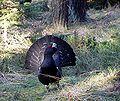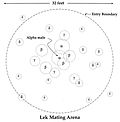Lek mating
Lek mating is a complex social and evolutionary phenomenon observed in various animal species, particularly among birds, but also in some mammals, fish, and insects. It refers to a behavior pattern where males congregate to engage in competitive displays, called leks, to attract potential mates. Females visit these arenas solely to mate, making the selection based on the males' display qualities. This article delves into the intricacies of lek mating, exploring its characteristics, evolutionary significance, and examples within the animal kingdom.
Characteristics[edit]
Lek mating is characterized by several key features:
- Aggregation of Males: Males gather in specific areas known as leks, which are typically located in open spaces that maximize visibility to females.
- No Resource Offering: Unlike other mating systems, males do not offer resources such as food or nest sites to the females. The primary focus is on the males' display.
- Female Choice: Females have the autonomy to choose their mates based on the males' display qualities, such as vocalizations, physical attributes, and display vigor.
- Male Competition: Males compete for the best display sites within the lek, as these are believed to increase their visibility to females.
Evolutionary Significance[edit]
The evolutionary significance of lek mating lies in its contribution to sexual selection and genetic diversity. It provides a mechanism for females to select mates based on traits that indicate genetic fitness, thus potentially enhancing the survival and reproductive success of their offspring. Lek mating also raises questions about the costs and benefits of sexual selection, particularly why males invest heavily in traits that may not have direct survival benefits.
Examples[edit]
- Birds: The sage grouse (Centrocercus urophasianus) and the black grouse (Tetrao tetrix) are well-known examples of birds that exhibit lek mating behavior. Males perform elaborate displays involving vocalizations, feather displays, and physical movements.
- Mammals: Among mammals, the Ugandan kob (Kobus kob thomasi) is noted for its lek mating system, where males defend small territories within a lek to attract females.
- Insects: Certain species of fruit flies and butterflies also display lek mating behaviors, gathering in specific locations to attract females through visual or chemical signals.
Conservation and Study[edit]
The study of lek mating has implications for conservation, particularly in species where habitat destruction threatens lek sites. Understanding the dynamics of lek mating can aid in the development of conservation strategies that protect these critical areas. Additionally, lek mating provides a valuable model for studying sexual selection and evolutionary biology.
See Also[edit]

-
Greater Sage-Grouse at Lek
-
Capercaillie
-
Lek Diagram
-
Paraclusia tigrina - Lekking Behaviour
-
Grackles Lekking
-
Tetrax tetrax in Castuera, Estremadura, Spain
-
Manacus manacus
-
Lekadvert
Ad. Transform your life with W8MD's Budget GLP-1 injections from $75


W8MD offers a medical weight loss program to lose weight in Philadelphia. Our physician-supervised medical weight loss provides:
- Weight loss injections in NYC (generic and brand names):
- Zepbound / Mounjaro, Wegovy / Ozempic, Saxenda
- Most insurances accepted or discounted self-pay rates. We will obtain insurance prior authorizations if needed.
- Generic GLP1 weight loss injections from $75 for the starting dose.
- Also offer prescription weight loss medications including Phentermine, Qsymia, Diethylpropion, Contrave etc.
NYC weight loss doctor appointmentsNYC weight loss doctor appointments
Start your NYC weight loss journey today at our NYC medical weight loss and Philadelphia medical weight loss clinics.
- Call 718-946-5500 to lose weight in NYC or for medical weight loss in Philadelphia 215-676-2334.
- Tags:NYC medical weight loss, Philadelphia lose weight Zepbound NYC, Budget GLP1 weight loss injections, Wegovy Philadelphia, Wegovy NYC, Philadelphia medical weight loss, Brookly weight loss and Wegovy NYC
|
WikiMD's Wellness Encyclopedia |
| Let Food Be Thy Medicine Medicine Thy Food - Hippocrates |
Medical Disclaimer: WikiMD is not a substitute for professional medical advice. The information on WikiMD is provided as an information resource only, may be incorrect, outdated or misleading, and is not to be used or relied on for any diagnostic or treatment purposes. Please consult your health care provider before making any healthcare decisions or for guidance about a specific medical condition. WikiMD expressly disclaims responsibility, and shall have no liability, for any damages, loss, injury, or liability whatsoever suffered as a result of your reliance on the information contained in this site. By visiting this site you agree to the foregoing terms and conditions, which may from time to time be changed or supplemented by WikiMD. If you do not agree to the foregoing terms and conditions, you should not enter or use this site. See full disclaimer.
Credits:Most images are courtesy of Wikimedia commons, and templates, categories Wikipedia, licensed under CC BY SA or similar.
Translate this page: - East Asian
中文,
日本,
한국어,
South Asian
हिन्दी,
தமிழ்,
తెలుగు,
Urdu,
ಕನ್ನಡ,
Southeast Asian
Indonesian,
Vietnamese,
Thai,
မြန်မာဘာသာ,
বাংলা
European
español,
Deutsch,
français,
Greek,
português do Brasil,
polski,
română,
русский,
Nederlands,
norsk,
svenska,
suomi,
Italian
Middle Eastern & African
عربى,
Turkish,
Persian,
Hebrew,
Afrikaans,
isiZulu,
Kiswahili,
Other
Bulgarian,
Hungarian,
Czech,
Swedish,
മലയാളം,
मराठी,
ਪੰਜਾਬੀ,
ગુજરાતી,
Portuguese,
Ukrainian






